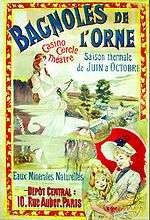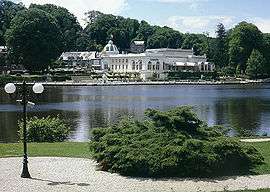Bagnoles-de-l'Orne
| Bagnoles-de-l'Orne | |
|---|---|
|
Lake and casino | |
 Bagnoles-de-l'Orne | |
|
Location within Lower Normandy region  Bagnoles-de-l'Orne | |
| Coordinates: 48°32′59″N 0°25′25″W / 48.5497°N 0.4236°WCoordinates: 48°32′59″N 0°25′25″W / 48.5497°N 0.4236°W | |
| Country | France |
| Region | Normandy |
| Department | Orne |
| Arrondissement | Alençon |
| Canton | Juvigny-sous-Andaine |
| Government | |
| • Mayor (2011–2014) | Jean Pierre Blouet |
| Area1 | 9.26 km2 (3.58 sq mi) |
| Population (2008)2 | 2,502 |
| • Density | 270/km2 (700/sq mi) |
| INSEE/Postal code | 61483 / 61140 |
|
1 French Land Register data, which excludes lakes, ponds, glaciers > 1 km² (0.386 sq mi or 247 acres) and river estuaries. 2 Population without double counting: residents of multiple communes (e.g., students and military personnel) only counted once. | |
Bagnoles-de-l'Orne is a commune in the Orne department in northwestern France.
On 1 January 2000, Tessé-la-Madeleine and Bagnoles-de-l'Orne merged becoming one town called Bagnoles-de-l'Orne, however, it adopted the former Insee code of Tessé-la-Madeleine (61483) for identification purposes.
Population
| Historical population | ||
|---|---|---|
| Year | Pop. | ±% |
| 1962 | 1,371 | — |
| 1968 | 1,456 | +6.2% |
| 1975 | 1,441 | −1.0% |
| 1982 | 1,716 | +19.1% |
| 1990 | 1,966 | +14.6% |
| 1999 | 2,172 | +10.5% |
| 2008 | 2,502 | +15.2% |
Spa

This commune is famous for its hydrotherapic baths, which are known for their supposed healing powers for rheumatic, gynaecologic and circulatory problems. The origins of thermal activity are said to date back to the Middle Ages. The spa is centred on the lake, which is formed by the River Vée, a tributary of the Mayenne, before it enters a deep gorge cut through the massif of the Andaines Forest.
Local legend tells of the medieval lord, Seigneur Hugues de Tessé. Believing that his once-glorious horse, "Rapide", was reaching the end of its life, Seigneur Hugues decided to abandon it in the Andaines Forest. He was amazed when the animal returned home some time later, strong and totally revitalized. Without resentment, "Rapide" took its master along to the waters of Bagnoles where he drank and was also rejuvenated. The spa was born.
According to another tale, a very old Franciscan monk who took the waters in Bagnoles found a new astonishing vigour and leapt across the highest rocks above the town, which are still called "Le Saut du Capucin" (The Monk's Leap).
Another facet of this fascinating place is the Arthurian legend, since Bagnoles and its surroundings are supposed to be Lancelot's country. The village's calendar of cultural events includes a visit of the most famous Arthurian sites.
The "Belle Époque" Quarter
The "Belle Époque" Quarter in Bagnoles-de-l'Orne constitutes a rather well preserved example of what could be classed as a typical early 20th century French bourgeoise residential area. Built between 1886 and 1914 and located in the southern part of the town, it is filled with superb villas with polychrome façades, bow windows and unique roofing. Similar projects were developed throughout France at the same time, among which are Le Vésinet close to Paris, the Saurupt Park in Nancy and the "Winter Town" of Arcachon.
Built under strict construction regulations and intended for well-off 'curists', that is, those attending the spa facilities, the idea of a residential area right in the heart of the Normandy forest attracted a very wealthy clientele. Moreover, when it was built, going to thermal pools wasn't generally popular, but seen, rather, as being associated with elitism, luxury and the aspirations of the privileged social classes, who took pleasure in promoting nature as a place of healing.
For this reason, Bagnoles-de-l'Orne is also known for the many prestigious visitors who have lived there at various times: the King and the Queen of Romania, Frank Jay Gould, the Prince of Montenegro, the Prince of Greece, Princess Bibesco, the Princess of Batenberg, Édouard Herriot, Alexandre Dumas (the father), and even the Maharani of Kapurthala.
The architectural opulence of constructions such as the Villas "Printania", "Le Castel", or the so-called "Swedish Country cottage" as well as the presence of large lavish hotels gives a good idea of the stunning taste of the "Fin de siècle" period. Being inspired by the Norman neo-regionalist style, as can be found in the Côte Fleurie (Flowered coast) resorts of Deauville, or Trouville, there can easily be said to be a distinct "Bagnolais" architectural style.
Art Deco architecture
After the long break caused by World War I, the development of tourism in Bagnoles-de-l'Orne eventually continued.
During this second period of great affluence, known in France as "Les Années Folles" ("Roaring Twenties"), the success of Bagnoles-de-l'Orne increased. The thermal season was filled with classical music concerts, horse races at the Hippodrome, golf tournaments as well as other sophisticated leisure activities. The demand for entertainment was high and a second casino was eventually built.
In keeping with the height of fashion, the buildings erected during this period were highly influenced by the "Art Deco" style, which was popular in the 1920s and 1930s.
Probably the most interesting examples of this type of architecture are the "Casino du Lac", built in 1927 by the renowned architect Auguste Bluysen,[1] and the "Saint Jean-Baptiste Church" (1934–1935), which is registered as a listed building. Both buildings have met the challenge to integrate well with the greenery of the surrounding landscape, while adding a touch of modern design, based on the use of geometric shapes and shades of white.
Heraldry
 |
The arms of Bagnoles-de-l'Orne are blazoned : Argent, 4 fesses wavy azure, chaussé vert, and on a chief gules, a leopard armed and langued azure. |
The Henri Cibois and Benjamin Saunier affair
The story of the attack and robbery against the Goupil widow, in the Tessé-la-Madeleine quarter of Bagnoles, in 1907, is well known in the area.
At the end of the reign of Louis XVI, the Groupil family lived in quite modest circumstances in Tessé, which was the original village and is now a part of Bagnoles. The Groupils had two sons, Jean and Louis, who, having both been missing since the French Revolution, reappeared and settled back in Tessé, in 1829. In 1825, they set about building a grand house called, at that time, "Le Logis", on the Place de L'Eglise. The locals expressed surprise at the Goupil brothers' apparent sudden rise to prosperity. The brothers died in 1850, taking with them the secret of their financial success. Soon after their death, Anne-Marie Goupil, the daughter of Jean and young wife, and so, widow of Louis, built a new house known as the "Chateau Goupil", which is Bagnoles' present Town Hall. Madame Goupil moved into the chateau and continued to live there for the rest of her life, with her son and daughter.[2]
The locals were said to be suspicious of where the Groupils had originally gained their wealth, but whether or not that led to the events which brought about the attack on Madame Groupil is not known.
On the night of 3 to 4 December 1907, Henri Cibois, a 24-year-old wheelwright, broke into the chateau with seventeen-year-old lumberman, Benjamin Saunier. Madame Groupil, now seventy-two years old, was beaten unconscious and suffered multiple stab wounds. Cibois and Saunier stole 700 francs, jewellery and three bottles of champagne.
For his crime, Henri Cibois went to the guillotine on 11 August 1908, with his accomplice, Benjamin Saunier being condemned to twenty years hard labour.[3]
Assassination of Carlo and Nello Rosselli
Carlo Rosselli (1899–1937) was a famous Italian socialist intellectual and activist during the years between World War I and World War II. He devoted his whole life and large amounts of money to the anti-fascist fight against Mussolini, Hitler, and Franco. He and his brother, Nello, were assassinated in Bagnoles-de-l'Orne on June 9, 1937,[4] by a group of "cagoulards", militants of the "Cagoule", a French fascist group,[5][6] probably on the orders of Mussolini.
Digital television
Lower Normandy, including Bagnoles, was the first region in France, together with Alsace, to change over completely to digital television reception, giving more channels with a higher quality of image and sound to residents. Digital signals were broadcast alongside digital from December 2009 until March 2010, when the analogue signal was switched off.[7]
See also
References
- ↑ Auguste Bluysen - French Wikipedia
- ↑ The story of the Goupil family
- ↑ Guillotine.voila.net Les condamnés à mort
- ↑ Stanislao G. Pugliese Death in Exile: The Assassination of Carlo Rosselli, Journal of Contemporary History, 32 (1997), pp. 305-319
- ↑ Stanislao G. Pugliese Death in Exile: The Assassination of Carlo Rosselli, Journal of Contemporary History, 32 (1997), pp. 305-319
- ↑ M. Agronsky, Foreign Affairs 17 391 (1938)
- ↑ Bagnoles le L'Orne Municipality: Digital Television
Gallery
-
Garden near the lake
-
The Hotel des Thermes
-
La Vée river
-
Town Hall - also known as Chateau Goupil
-
Pavillon des Fleurs
-
Church Saint-Jean-Baptiste
-
The lake
-
Bagnole de l'Orne
External links
| Wikimedia Commons has media related to Bagnoles-de-l'Orne. |
- Excerpt from the diary of Mary King Waddington on her visit to Bagnoles de l'Orne at the height of the Belle Epoque, with photos and images
- Official website
- Thermal Baths website
